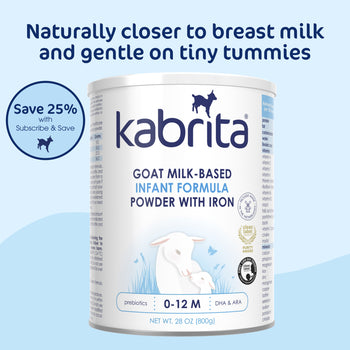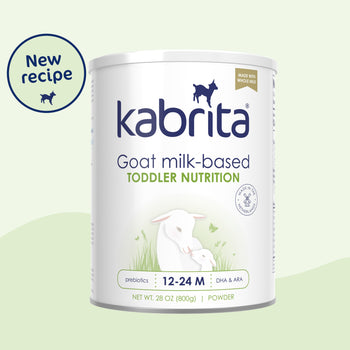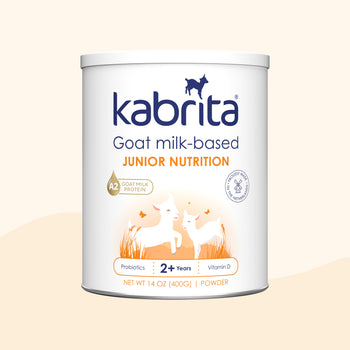New & Improved Kabrita Goat Milk-Based Toddler Nutrition Drink

We’re excited to introduce you to our new and improved Goat Milk-Based Toddler Nutrition!
Our new Toddler Nutrition drink is formulated using whole goat milk as the primary fat source, with protein and micronutrients designed to meet the specific needs of US toddlers. Even picky eaters love the creamy, mild taste of Kabrita, while parents love its naturally easy-to-digest goat milk and clean-label ingredients.
What’s new in our Toddler Nutrition? Let’s break it down
Gentle goodness from grass-fed goat milk
We’re proud to use whole goat milk as our primary fat source in Toddler Nutrition. This supports the expert guidance that toddlers 12-24 months should enjoy whole-fat milk.
Our goat milk comes from grass-fed goats on family-run farms in the Netherlands.
Nutrients that support growing bodies & busy brains
We’ve carefully fortified our whole-fat goat milk base with essential nutrients to support the growth and development of toddlers in the U.S.
Vitamin D
Why it’s important: Essential for bone development and calcium absorption.1
More than ¾ of US toddlers are not getting enough vitamin D.2
Calcium
Why it’s important: Supports peak bone mass and helps reduce fractures and osteoporosis later in life.3
Iron
Why it’s important: Critical for oxygen transport, red blood cell formation, immune health, and cognition.4
Iron deficiency affects about 14% of US toddlers aged 1-2 years.5
Potassium
Why it’s important: Supports nerve, muscle, and heart health.6
Nearly 95% of US preschoolers do not get enough potassium.7
Vitamin E
Why it’s important: Supports immunity, vision, and brain development.8
76% of US toddlers are not getting enough vitamin E.2
Phosphorus
Why it’s important: Essential for energy production and cellular function.9
Choline
Why it’s important: Supports memory, mood, muscle control, and the nervous system.
49% of US toddlers are not getting enough choline.2
DHA & ARA
Why it’s important: Crucial for brain, eye, and neurological development.10 Supplementation is associated with better cognition and language in toddlers.11
About 98% of US toddlers are not getting enough DHA.2
Fun fact: We use plant-based, vegetarian sources for our DHA and ARA, rather than marine sources.
Protein
Why it’s important: Helps build and maintain tissues, muscles, and organs, and serves as enzymes, hormones, and antibodies.12
Our protein comes from goat milk, which is naturally easier to digest than cow’s milk protein.13,14 The protein amount in our Toddler Nutrition drink is formulated to meet the needs of US toddlers.
Get your sippy cups ready for a new scoop
If you have used Kabrita in the past, please note that our scoops are now slightly larger and have a different ratio of powder to water. As always, when preparing a powdered drink, follow the instructions on the label and use only the scoop provided in the can.
Support for gut health and immunity
Toddler Nutrition now includes both probiotics and prebiotics.
The probiotic Bifidobacterium animalis (BB-12) is one of the most studied probiotic strains. It has been shown to support gut health, improve bowel function, protect against diarrhea, reduce the side effects of antibiotics, and even increase the body’s resistance to respiratory infections.15 Toddlers can experience up to 10 respiratory infections and 5 episodes of diarrhea per year.16,17
Prebiotic galacto-oligosaccharides (GOS) and fructo-oligosaccharides (FOS) provide lasting energy and support both immunity and gut health.18
What’s not changing?
Our commitment to safety and transparency remains the same.
❌ No corn syrup
❌ No GMOs
❌ No antibiotics
❌ No growth hormones
❌ No pesticide residues
We test every batch for heavy metals against both European and internal standards to ensure the safety of your little ones and peace of mind for you.
Questions? We’re here to help!
Our customer service team is available to support you and your family through this transition.
Email: hello@kabrita.ca
Call: 1-855-816-3999
References
1. CDC. Vitamin D. Infant and Toddler Nutrition. November 26, 2024. Accessed April 30, 2025. https://www.cdc.gov/infant-toddler-nutrition/vitamins-minerals/vitamin-d.html
4. Iron. Accessed March 20, 2025. https://ods.od.nih.gov/factsheets/Iron-Consumer/
6. Potassium. Accessed March 20, 2025. https://ods.od.nih.gov/factsheets/Potassium-Consumer/
8. Resahb D. Efficacy of vitamin E in pediatric health: An exploration of its vital role. Oxid Antioxid Med Sci. 2023;12(9). Accessed March 20, 2025. https://www.ejmoams.com/ejmoams-articles/efficacy-of-vitamin-e-in-pediatric-health-an-exploration-of-its-vital-role-103541.html
9. Phosphorus. Accessed March 20, 2025. https://ods.od.nih.gov/factsheets/Phosphorus-Consumer/
16. Colds in children. Paediatr Child Health. 2005;10(8):493-495.



